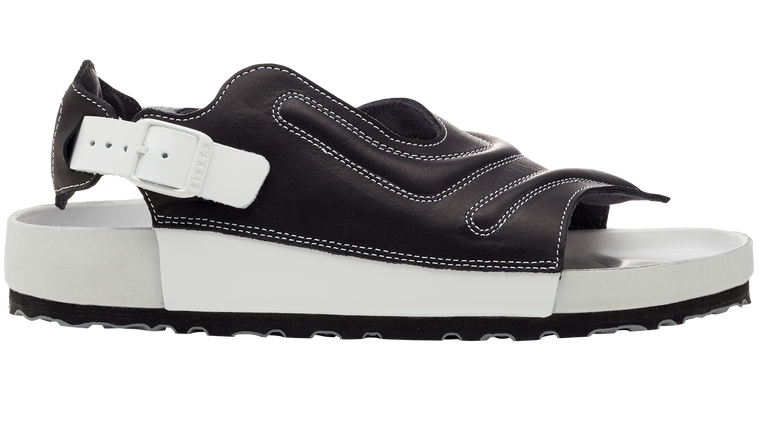Can fashion and activism be combined?
Definitely, fashion and how we dress are the first visual manifestations of representation.
Without opening our mouths to say anything, fashion can already speak visually for us. Make people feel something. What we choose to wear, depending on the look, materiality and combination of garments can be intended as activism and can be defiant.
Would you say that your design work is something of a manifesto? If so, what are you trying to state or argue?
My work is a manifesto and a reflection of my personal trans-national migratory heritage and lifestyle. I push for a borderless, less violent and more culturally accepting world. My work represents and showcases the positives I experience from this transnational way of life, which is something I envision for the world.
I aim to disarm prejudice with my design practice.
What role can fashion play in combating prejudice and helping people to embrace cultural differences?
Fashion can play an integral role in the road towards acceptance. I feel fashion should step away from trends and encourage people around the world to be more independent in their dress choices. This will create a public environment where it would be normal not to conform. We would all become accustomed to seeing our differences and hence this will hopefully lead to less prejudices and face values.
How has your work been shaped by your time at Central Saint Martins? What is it that gives the school such a world-renowned reputation?
Mostly it is being surrounded by the lion’s share of the best and strongest talent around; your peer students and tutors. The Masters at CSM is a melting pot of nationalities and backgrounds, all coming from different bachelor degrees and schools, this opens doors to different conversations and points of view, yet you have all congregated at the same institution. To me this implies that within our differences we have commonalities. Fundamentally this is what my work and practice are about, and the school allowed me free range to discover and research that part of myself to the fullest, to be able to produce my strongest and most genuine work.
What fascinated your most about your explorations into the Birkenstock archive, and how did that shape your eventual design?
I was fascinated by the technology and composition of the iconic cork and latex footbed. It is the foundation that Birkenstock rests upon and it’s the foundation that you physically stand on when wearing the sandal. I felt instantly it should be my starting point to the design process.
You shoe draws inspiration from the iconic Birkenstock cork footbed. What was it about this part of the shoe that captured your imagination?
I was inspired by the beauty of its functionality. It was created based on a shaped derived from our natural form. The imprints of our feet and where the pressures lie. The footbed consists of two shapes that I feel are effortlessly aesthetic. It seemed inevitable for me to bring them out from under the foot and shine a spotlight on the iconic sole Birkenstock is built upon. I wanted to create a cushioned upper to go hand in hand with the footbed - to celebrate its heritage.
One of your references was the idea of a footprint left behind in the sand. The beach has such positive connotations - would you say that your shoe explores ideas of escape, freedom and optimism?
My shoe reflects optimism and freedom. I believe my outlook on life is optimistic, hence why in my work I try to offer an optimistic solution. I see no point in designing something if it would dwell in the negative. I use the negative space in a positive way. But I don’t see this shoe as an escape, it is rather optimistic realism. The imprint is a reference to our ecological footprint, asking to consider our impact and showcasing Birkenstock as a brand that has continued to produce all parts of their shoes in Germany and sourced all materials in Europe. Something we should all strive to do more. This design is a celebration of natural beauty and form that I believe Birkenstock has built its functionality and success upon.
What roles should comfort and functionality play within fashion?
Comfort from a functionality point of view is important within fashion; garments are intended to be worn and should do their basic job. But I also see comfort as a more emotional aspect within design. How does the garment make you feel and how do you hold yourself when you wear it? Does it accompany you in expressing who you are and how you feel? It should reiterate what you stand for. I believe comfort should work hand in hand with the design concept and manifesto. Fashion should stand by us in expressing what we are about.
What are your hopes for you and your peers as the next generation of designers?
As a designer who graduated at the end of March, the covid-19 crisis and lockdown have been a blessing in disguise. This crisis will impact our world and how we behave. In this context, I believe it is an unprecedented opportunity for young designers to find a new way into a reinvented market and present novel concepts and designs in this turbulent time and challenge the existing status quo of the mass-produced, capitalist, throw away, dispersed production and non- genuine culture we are drowning in. This time confirms that there is room to have a small-scale practice. I see my personal future as being a designer who works more like an artist. I hope to have projects, collaborations just like this Birkenstock one, make unique pieces, be impactful by producing less and more meaningful manifestos.






